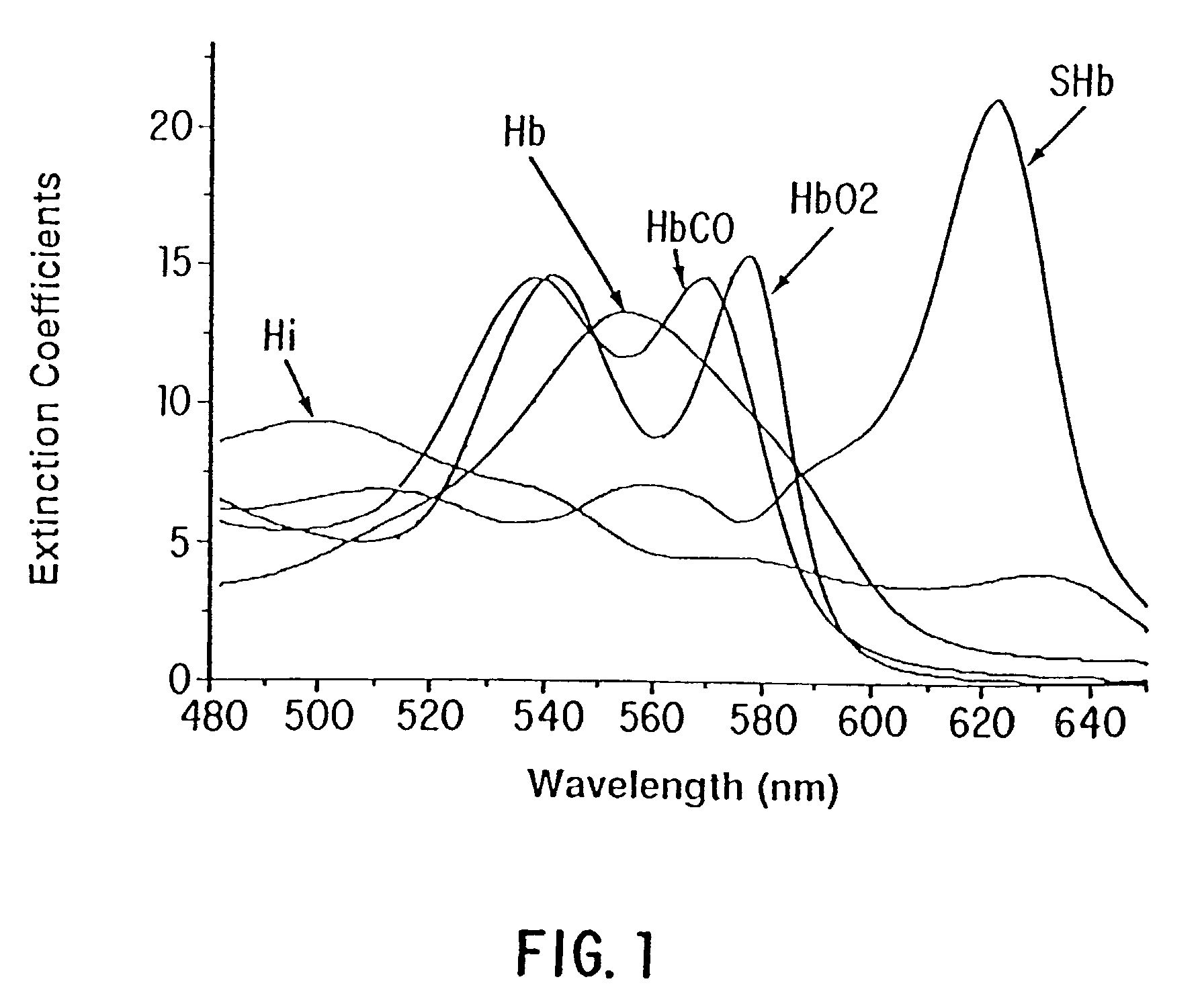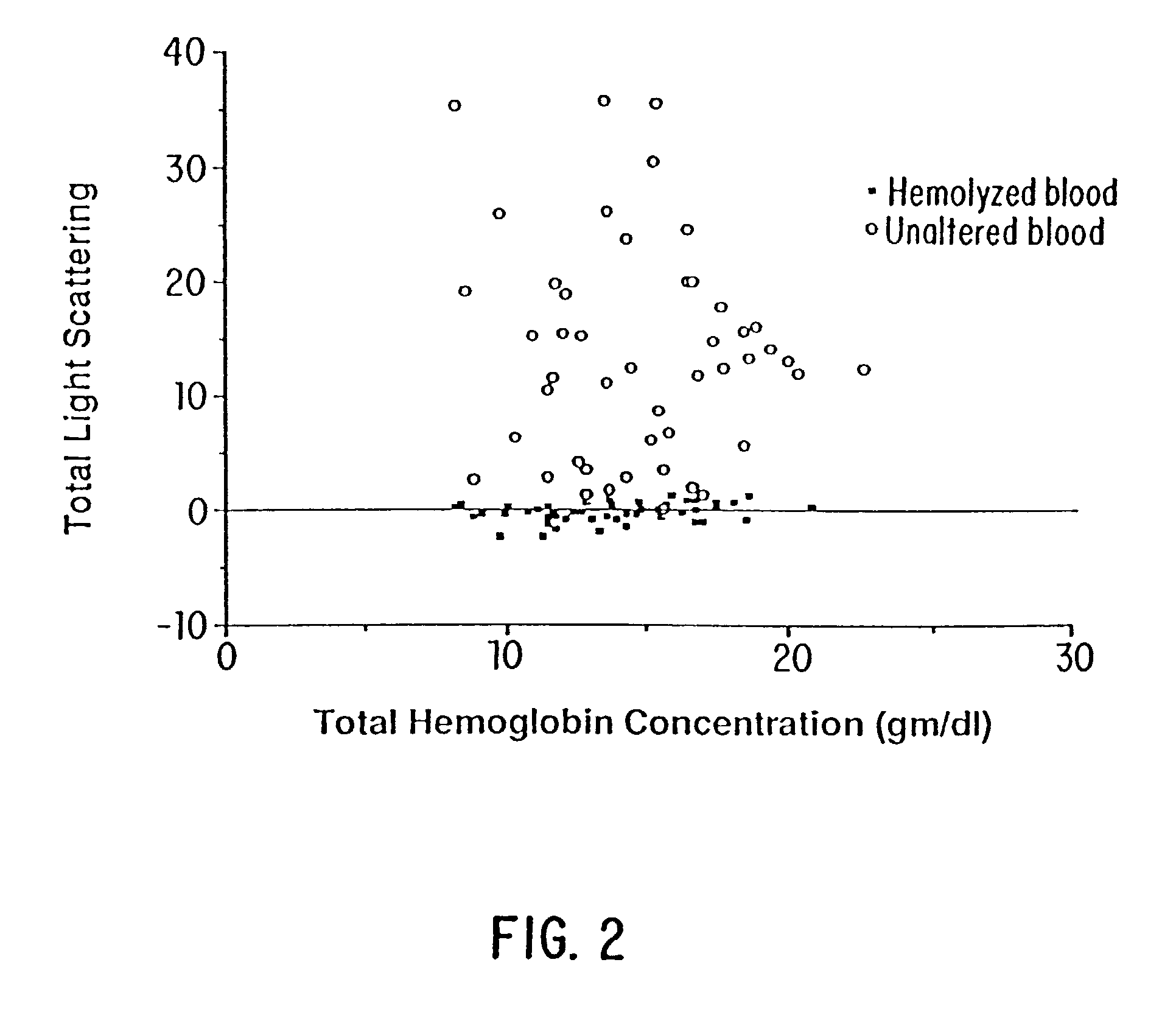Method and apparatus for direct spectrophotometric measurements in unaltered whole blood
a technology of unaltered whole blood and spectrophotometric measurement, which is applied in the direction of measurement devices, color/spectral properties measurement, instruments, etc., can solve the problems of slow chemical conversion, inability to measure the original concentration of several individual species, and inability to employ single wavelength methods to measure the total hemoglobin concentration spectrophotometrically
- Summary
- Abstract
- Description
- Claims
- Application Information
AI Technical Summary
Benefits of technology
Problems solved by technology
Method used
Image
Examples
embodiment a
[0080]ODiabs / d=eiHbO2[HbO2]+eiHbCO[HbCO]eiHi[Hi]+eiHb[Hb]+eiSHb[SHb]+eibr[br][OD1 / dOD2 / dOD3 / dOD4 / dOD5 / dOD6 / dOD7 / d]=[e1HbO2e1HbCOe1Hie1Hbe1SHbe1brs1RBCe2HbO2e2HbCOe2Hie2Hbe2SHbe2brs2RBCe3HbO2e3HbCOe3Hie3Hbe3SHbe3brs3RBCe4HbO2e4HbCOe4Hie4Hbe4SHbe4brs4RBCe5HbO2e5HbCOe5Hie5Hbe5SHbe5brs5RBCe6HbO2e6HbCOe6Hie6Hbe6SHbe6brs6RBCe7HbO2e7HbCOe7Hie7Hbe7SHbe7brs7RBC][[HbO2][HbCO][Hi][Hb][SHb][br]mRBCscat](6A)THb=[HbO2]+[HbCO]+[Hi]+[Hb]+[SHb][s1RBCs2RBCs3RBCs4RBCs5RBCs6RBCs7RBC]=[s1RBC(HbO2)s1RBC(HbCO)s1RBC(Hi)s1RBC(Hb)s1RBC(SHb)s2RBC(HbO2)s2RBC(HbCO)s2RBC(Hi)s2RBC(Hb)s2RBC(SHb)s3RBC(HbO2)s3RBC(HbCO)s3RBC(Hi)s3RBC(Hb)s3RBC(SHb)s4RBC(HbO2)s4RBC(HbCO)s4RBC(Hi)s4RBC(Hb)s4RBC(SHb)s5RBC(HbO2)s5RBC(HbCO)s5RBC(Hi)s5RBC(Hb)s5RBC(SHb)s6RBC(HbO2)s6RBC(HbCO)s6RBC(Hi)s6RBC(Hb)s6RBC(SHb)s7RBC(HbO2)s7RBC(HbCO)s7RBC(Hi)s7RBC(Hb)s7RBC(SHb)][[HbO2] / THb[HbCO] / THb[Hi] / THb[Hb] / THb[S...
embodiment b
[0081]ODiabs / d=eiHbO2[HbO2]+eiHbCO[HbCO]eiHi[Hi]+eiHb[Hb]+eibr[br][OD1 / dOD2 / dOD3 / dOD4 / dOD5 / dOD6 / dOD7 / d]=[e1HbO2e1HbCOe1Hie1Hbe1brs1RBCs1NSe2HbO2e2HbCOe2Hie2Hbe2brs2RBCs2NSe3HbO2e3HbCOe3Hie3Hbe3brs3RBCs3NSe4HbO2e4HbCOe4Hie4Hbe4brs4RBCs4NSe5HbO2e5HbCOe5Hie5Hbe5bre5RBCs5NSe6HbO2e6HbCOe6Hie6Hbe6bre6RBCe6NSe7HbO2e7HbCOe7Hie7Hbe7brs7RBCs7NS][[HbO2][HbCO][Hi][Hb][br]mRBCscatmNSscat](6B)THb′=[HbO2]+[HbCO]+[Hi]+[Hb]+[SHb][s1RBCs2RBCs3RBCs4RBCs5RBCs6RBCs7RBC]=[s1RBC(HbO2)s1RBC(HbCO)s1RBC(Hi)s1RBC(Hb)s2RBC(HbO2)s2RBC(HbCO)s2RBC(Hi)s2RBC(Hb)s3RBC(HbO2)s3RBC(HbCO)s3RBC(Hi)s3RBC(Hb)s4RBC(HbO2)s4RBC(HbCO)s4RBC(Hi)s4RBC(Hb)s5RBC(HbO2)s5RBC(HbCO)s5RBC(Hi)s5RBC(Hb)s6RBC(HbO2)s6RBC(HbCO)s6RBC(Hi)s6RBC(Hb)s7RBC(HbO2)s7RBC(HbCO)s7RBC(Hi)s7RBC(Hb)][[HbO2] / THb′[HbCO] / THb′[Hi] / THb′[Hb] / THb′](7B)[s1NSs2NSs3NSs4NSs5NSs6NSs7NS]=[s1NS(HbO2)s1NS(HbCO)s1NS(Hi)s1NS(Hb)s2NS(Hb...
embodiment c
[0110]ODiabs=eiHbO2[HbO2]+eiHbCO[HbCO]+eiHi[Hi]+eiHb[Hb]+eiSHb[SHb]+eibr[br][OD1 / dOD2 / dOD3 / dOD4 / dOD5 / dOD6 / dOD7 / dOD8 / d]=[e1HbO2e1HbCOe1Hie1Hbe1SHbe1brs1RBCs1NSe2HbO2e2HbCOe2Hie2Hbe2SHbe2brs2RBCs2NSe3HbO2e3HbCOe3Hie3Hbe3SHbe3brs3RBCs3NSe4HbO2e4HbCOe4Hie4Hbe4SHbe4brs4RBCs4NSe5HbO2e5HbCOe5Hie5Hbe5SHbe5brs5RBCs5NSe6HbO2e6HbCOe6Hie6Hbe6SHbe6brs6RBCs6NSe7HbO2e7HbCOe7Hie7Hbe7SHbe7brs7RBCs7NSe8HbO2e8HbCOe8Hie8Hbe8SHbe8brs8RBCs8NS][[HbO2][HbCO][Hi][Hb][SHb][br]mRBCscatmNSscat](6C)[s1RBCs2RBCs3RBCs4RBCs5RBCs6RBCs7RBCs8RBC]=[s1RBC(HbO2)s1RBC(HbCO)s1RBC(Hi)s1RBC(Hb)s1RBC(SHb)s2RBC(HbO2)s2RBC(HbCO)s2RBC(Hi)s2RBC(Hb)s2RBC(SHb)s3RBC(HbO2)s3RBC(HbCO)s3RBC(Hi)s3RBC(Hb)s3RBC(SHb)s4RBC(HbO2)s4RBC(HbCO)s4RBC(Hi)s4RBC(Hb)s4RBC(SHb)s5RBC(HbO2)s5RBC(HbCO)s5RBC(Hi)s5RBC(Hb)s5RBC(SHb)s6RBC(HbO2)s6RBC(HbCO)s6RBC(Hi)s6RBC(Hb)s6RBC(SHb)s7RBC(HbO2)s7RBC(HbCO)s7RBC(Hi)...
PUM
 Login to View More
Login to View More Abstract
Description
Claims
Application Information
 Login to View More
Login to View More - R&D
- Intellectual Property
- Life Sciences
- Materials
- Tech Scout
- Unparalleled Data Quality
- Higher Quality Content
- 60% Fewer Hallucinations
Browse by: Latest US Patents, China's latest patents, Technical Efficacy Thesaurus, Application Domain, Technology Topic, Popular Technical Reports.
© 2025 PatSnap. All rights reserved.Legal|Privacy policy|Modern Slavery Act Transparency Statement|Sitemap|About US| Contact US: help@patsnap.com



